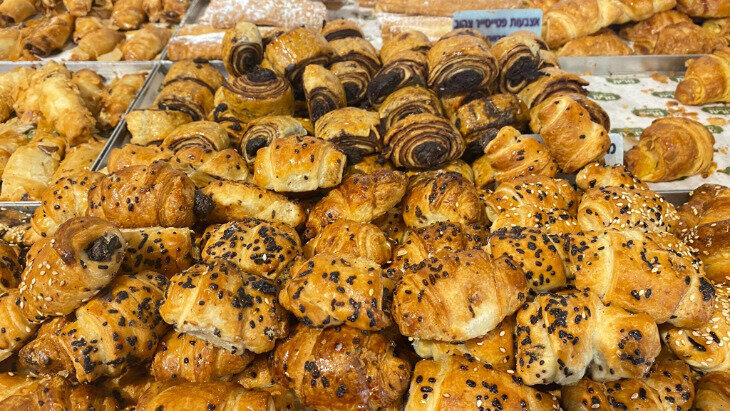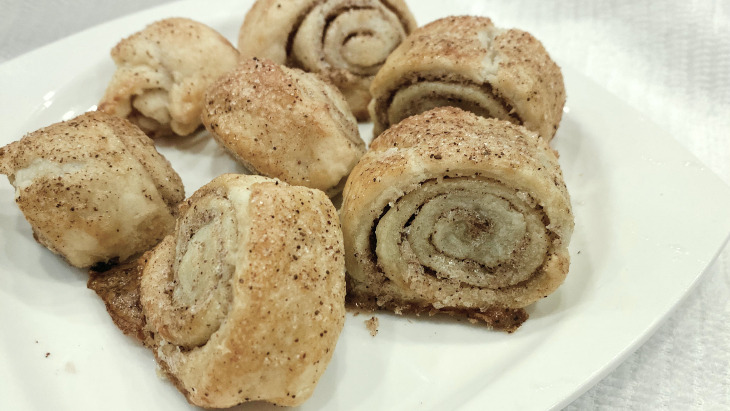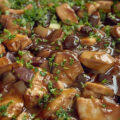Anyone who’s been to the Shuk, an open air market, in Israel has smelled the aroma of freshly baked Rugelach in the streets, all from the local bakeries pumping out pastries for the hungry customers waiting. But what exactly are all these tourists waiting in line for? What is this sweet, gooey, chocolatey dessert that looks almost like a shrunken croissant? Where does it come from, and what’s so special about the Israeli variation that people come from all around the world to try it?
What is Rugelach?
Rugelach is a flaky, buttery Ashkenazic Jewish pastry that is traditionally filled with chocolate, cinnamon, fruit preserves, or halva. It is a staple in most Jewish bakeries and is eaten year round, especially on the holidays and on Shabbat.
The History of Rugelach in Europe
Rugelach is a traditional Eastern European pastry, which got its name from the Yiddish word for “little twists.”
The parallels between Rugelach and croissants don’t end at their similar shapes and sizes. Rugelach was invented around the same time as the croissant, in 1683. According to some sources, it was created to commemorate the expulsion of the Turks and the lifting of the Turkish siege in Austria. Since the pastry’s shape resembled the Ottoman Empire's emblem, it was a way for people to metaphorically eat their enemies.
However, while the croissant remained plain to be eaten with butter or cheese, the Rugelach was seen as more of a dessert pastry, being filled with an assortment of fruit jams or poppy seed pastes.
Variations and Flavors of Rugelach
Throughout the hundreds of years of Rugelach we’ve found some pretty creative reinventions for the classic Jewish dessert. Halva, cinnamon, chocolate, apricot are all common rugelach fillings. However, in recent years a few creative chefs have decided to forego the notion of rugelach as a dessert by filling it with garlic, cheese or artichoke, and taking the classic old-country food and renewing it with modern flavors and techniques, find recipes for savory rugelach here.
Israeli Rugelach vs. American Rugelach
Gil Marks, a Jewish food historian has written at length on the differences between American and Israeli Rugelach.
He wrote in his book, “The Encyclopedia of Jewish Food,” that in the late 19th century and early 20th century, which coincided with the Eastern European Jewish immigration wave, the classic Eastern European dessert made its way to America.
The recipe that had remained relatively unchanged for centuries underwent a massive change upon its arrival in the New World. In America, nobody had time to spend hours preparing a yeast dough, everything had to be prepared quickly and efficiently. So American bakers created a rugelach dough that used cream cheese instead of yeast, which was the classic preparation of the dough. This small change had a massive impact on the flavor and texture of Rugelach in America, making it closer to a cookie than a pastry.
Rugelach arrived in Israel during the several waves of Aliyah in the late 1800s and early 20th century, before the modern state of Israel was founded. It is believed that it was brought to Israel by Hungarian and Polish immigrants. In contrast with America, in Israel the immigrants continued to prepare Rugelach using the traditional methods that required a yeast dough. In fact, some fancy Israeli bakers even started using a laminated yeast dough (just like the dough used in French croissants), making it even more difficult and time-consuming to prepare.
The differences in preparation, despite the shared roots, shines a light on one of the differences in Israeli culture and American Jewish culture – the dedication to tradition.
The Israeli Jews stuck to the more time-consuming method for the dessert, because it was their way to hold on to their heritage and history of the old country. Whereas in America, it became far more challenging for the Jewish people to keep the older methods among the variety of new cultural influences, access to new and different types of products, and assimilation into Western society.
We can learn from the two types of Rugelach about our culture and history, as well as the differences in Jewish immigrants from different places in the world. By learning more about the history and origins of our favorite dishes, we can gain some food for thought to keep in mind the next time we take a bite of the classic Jewish pastry.
Which rugelach do you prefer?
Chocolate Israeli Style Rugelach
We made the Israeli yeast based dough version with a rich chocolate filling, but you can feel free to use your favorite jams or spreads.
Or
Cinnamon American Style Rugelach
This one is flakier, almost like pie dough so we went with a cinnamon sugar filling, but feel free to add chopped nuts or use jam.
Let’s put them to the test, try them both and let us know which one you prefer, spoiler alert, I couldn’t choose, loved them both!

















